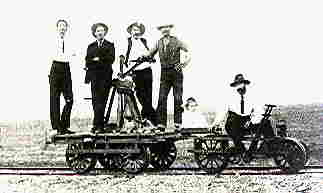|
Outback Info (Private Seiten) © seit 1999
Oodnadatta Track
The road from Marree to Oodnadatta, via Coward Spring, Curdimurka, Lake Eyre,
William Creek, Algebuckina and numerous red and white sand dunes, follows a line
of mound springs. Known for thousands of years by the Aborigines they were 'discovered'
in the late 1850s by the explorers and used by pastoralists as stepping stones
into the arid north of South Australia.
The first of these mound springs is the Hergott Springs just north of Marree.
Others are found at Callana Station, Finniss Springs, Warburton and Loudon
Springs. One of the best known is the Bubbler. The Oodnadatta track follows
almost the same route as that taken by John McDouall Stuart when he successfully
crossed Australia.
Coward Springs.
Later developments along this track were the Overland Telegraph Line and the
Great Northern Railway or Central Australian Railway. This train became known as
The Ghan. Some of the visible remains of this line are the many bridges and
Fettler Cottages. Some can still be seen at Marree, Wangianna, Curdimurka,
Margaret, Beresford, Anna Creek, Boorthanna, Edwards Creek, Warrina, Peake
Creek, Algebuckina and Mount Dutton.
The Critic, an Adelaide weekly, wrote in October 1897; 'Very few South
Australian people know that in their own country there is a watering place which,
as far as the curative properties of the springs go, is equal to any of the much
vaunted German resorts. An analysis of the Oodnadatta bore water has shown that
it contains precisely the same amount of sulphur and other minerals as the noted
Heilbron Springs. Of course, Oodnadatta is just about the last spot that any
sane person would choose for a holiday resort under present circumstances, but
surely it would pay the Government to make the place attractive. Almost any kind
of trees, including the stately palms and other tropical forest species, could
be grown in a garden around the bore'. Unfortunately for Oodnadatta the
government never did.
On several occasions gold has been discovered and mined at The Peake or Neales
River, Algebuckina and Mount Dutton. Copper was mined at the Clara St Dora, at
one stage owned and operated by Copley identity Frank Montegue. The only town
between Marree and Oodnadatta is William Creek which often has a population of
four or five people, plus a number of cats and dogs. Situated about halfway on
the track it has the only "watering hole" within hundreds of kilometres, and is
a must to visit.
In April 1924 the United Aborigines' Mission (UAM), influenced by Annie Lock,
opened its first of several missionary facilities at Oodnadatta. At first it
operated from a small iron shed but soon had a school, church and a cottage for
children. Other sisters to work at Oodnadatta were, Ruby May Hyde, Miss Harris,
before she married missionary Frank Wade and Miss Smith.
Although the population along the track is small now, it certainly has not
always been that way. Just opposite the hotel is Anna Creek, the world's largest
cattle station.
Oodnadatta, Aboriginal for 'blossom of the Mulga' was proclaimed a government
town in October 1890 in readiness for the coming of the railway from Warrina.
The town became an important centre and soon had a population of 150 people.
However when The GHAN stopped coming through in 1980, the population declined
rapidly.
 
The End of the line.
However, when the Ghan did stop at Oodnadatta the town was alive and very busy.
Talking about these days during 1935, Ernestine Hill wrote an article for the
Advertiser in which she said, Oodnadatta was a Mecca for drovers and the
teamsters of the top half of the continent and a depot of the camel caravans of
the desert. About 150 Afghans, with their wives and families lived there when as
many as five cattle trains came through. One of these teamsters was Tom Simpson.
His son Horace, born in Kapunda, arrived with his mother and sister in 1910 to
join their father. Horace eventually became an engine driver and was to record
much of the town's history. One of the last Afghans in town was Ibrahim Khan.
|

